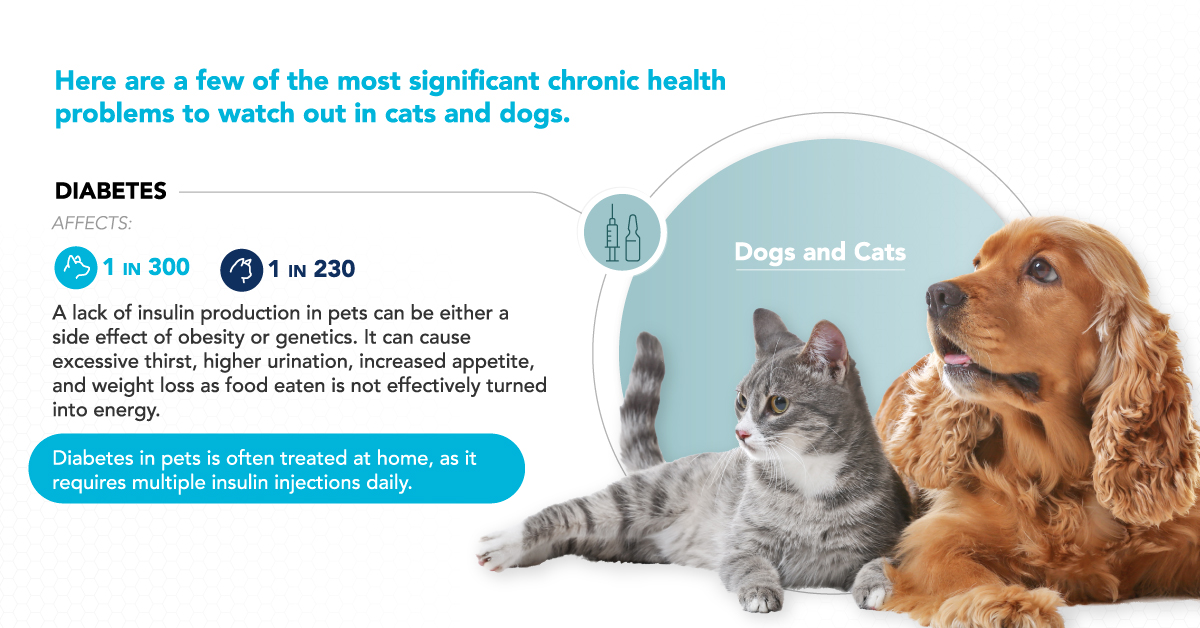Putting Pet Health First: Chronic Illnesses in Dogs and Cats
The following content is sponsored by NuGen Medical Devices.

Putting Pet Health First: Chronic Illnesses in Dogs and Cats
If you own pets, do you consider them a part of your family?
With pet ownership trends on the rise, particularly among younger generations, the pet care market is booming too. This includes a growing awareness of the different pet health conditions that one’s pet may face—especially chronic illnesses.
This infographic from NuGen Medical Devices looks at some of the most common chronic illnesses in dogs and cats, and how prevalent they are.
The Global Pet Health Industry
High shares of many generations reported considering their pets as “beloved family members”, according to a survey of pet owners. However, to take this further, Millennials and Gen Z cohorts reported seeing themselves more as “pet parents” instead of owners.
This is partially what is behind the bourgeoning rise of the pet care market, which is set to surpass $350 billion by 2027, at a compound annual growth rate of 6.1% between 2020-2027P.
Another driver of this market is that pets are a long-term commitment, which makes the industry relatively recession-proof as no matter the conditions, people continue to invest in making sure their pets have a high quality of life. This is helping many pets to live longer on average:
- Outdoor cats: 5-7 years
- Medium to large dogs: 8-13 years
- Small dogs: 10-15 years
- Indoor cats: 13-17 years
However, the older a pet gets, the more at-risk that pet is of developing a chronic illness.
The Most Common Chronic Illnesses in Cats and Dogs
Chronic illnesses can last a lifetime, and require ongoing treatment. Here are a few of the most significant chronic health problems in pets to watch out for.
| Chronic illness | Affects | Description |
|---|---|---|
| Diabetes | 1 in 300 dogs 1 in 230 cats | A lack of insulin production in pets can be either a side effect of obesity or genetics. It can cause excessive thirst, higher urination, increased appetite, and weight loss as food eaten is not effectively turned into energy. |
| Obesity | 1 in 5 dogs 1 in 3 cats | Can be caused by a poor diet and/or lack of exercise. May be a side effect of other illnesses like hypothyroidism. |
| Cancer | 1 in 4 dog 1 in 5 cats | The uncontrolled growth of malignant tumors develop into cancers. Warning signs include difficulty breathing/ eating, non-healing wounds, and unexplained swelling. |
| Glaucoma | 2 in 100 dogs 1 in 5 cats | Increased intraocular pressure leads to improper fluid drainage in the eyes. This results in impaired vision or blindness. |
| Hypothyroidism | Up to 8 in 1000 dogs | Stemming from thyroid hormone deficiency, it can result in inactivity, hair loss, and weight gain. |
| Osteoarthritis | 1 in 5 dogs | Degeneration in joints due to injury or age results in stiffness, swelling and aching joints, and serious mobility issues. |
| Lower urinary tract | Up to 8 in 100 cats | Frequent or very little urination can be a sign. May be caused by stress, infections, or urinary stones. |
| Kidney disease | 1 in 3 cats | Frequent (clear) urination may signify this, as well as weight loss and vomiting. |
| Hyperthyroidism | 1 in 10 cats | Overproduction of thyroid hormones can increase metabolism. This can lead to weight loss, increased appetite, or difficulty breathing. |
In addition to these illnesses, many of them also result in chronic pain, symptoms of which include:
- Reduced appetite
- Mobility changes e.g. stiffness
- Irritable or anxious behavior
To treat chronic illnesses and manage pain, pets are frequently brought to the vet for antibiotics, steroids, insulin, anti-inflammatory drugs, and more. For many, multiple injections are involved.
Needle-free treatments are growing in appeal, as they can be used anytime, anywhere. NuGen MD’s medical devices offer a painless and convenient way to care for the health of furry family members from home.
-

 Sponsored3 years ago
Sponsored3 years agoMore Than Precious: Silver’s Role in the New Energy Era (Part 3 of 3)
Long known as a precious metal, silver in solar and EV technologies will redefine its role and importance to a greener economy.
-

 Sponsored7 years ago
Sponsored7 years agoThe History and Evolution of the Video Games Market
Everything from Pong to the rise of mobile gaming and AR/VR. Learn about the $100 billion video games market in this giant infographic.
-

 Sponsored8 years ago
Sponsored8 years agoThe Extraordinary Raw Materials in an iPhone 6s
Over 700 million iPhones have now been sold, but the iPhone would not exist if it were not for the raw materials that make the technology...
-

 Sponsored8 years ago
Sponsored8 years agoThe Industrial Internet, and How It’s Revolutionizing Mining
The convergence of the global industrial sector with big data and the internet of things, or the Industrial Internet, will revolutionize how mining works.


